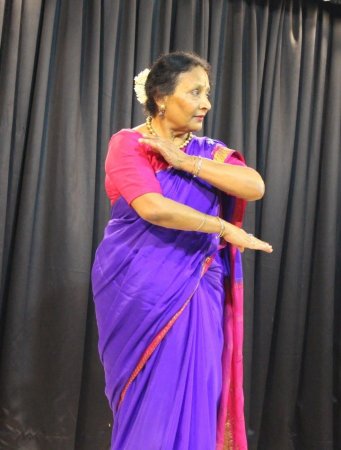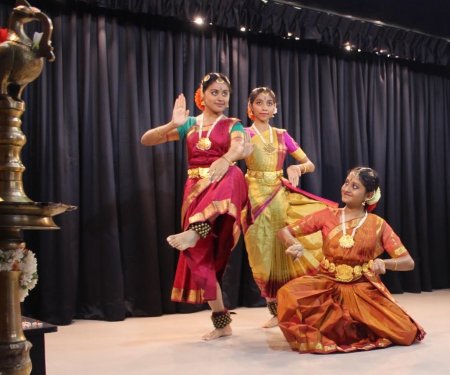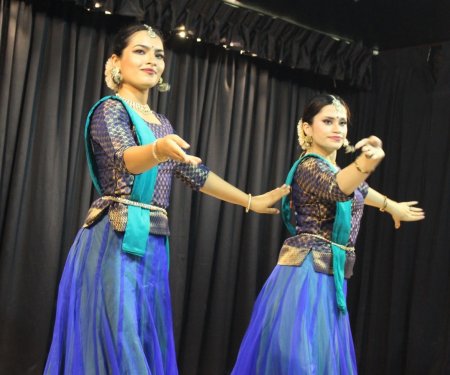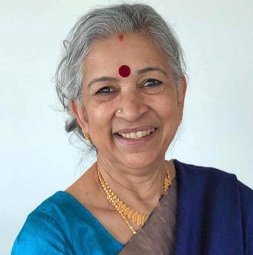
|   |

|   |
Captivating and enlightening dance demo on ‘Chakra philosophy’ - Rajeswari Iyer e-mail: iyer.rajeswari@gmail.com Photos: Srinath Salvadhi July 9, 2024 Dance is both a high art form and a cultural experience that everyone from children to the elderly can enjoy. Watching a dance performance is definitely a great stress buster. It works wonders for me. On 30th of June 2024, I happened to attend a lecture demonstration of chosen Kathak choreography to ‘Chakra philosophy’ originally set in Bharatanatyam, followed by dance demonstrations by students. It was a very interesting two and a half hour programme which began at 10.30am at Ananya Auditorium, Malleswaram, Bangalore.  Padmaja Suresh  Nilima Devi Aatmalaya academy, Bangalore, in collaboration with Nadam and CICD, UK presented excerpts from ‘Aarohan’, a thematic production based on Chakra philosophy. It was an amazing programme to showcase the collaborative project between Dr Padmaja Suresh of Aatmalaya and Nilima Devi. Nilima Devi has done tremendous work to keep the Kathak tradition alive in Leicester while the former who is an acclaimed dancer, author and research scholar has devised an aesthetic visualisation of the energy wheels or Chakras integrating Yoga, Tantra and deity worship. This novel project seems adaptable to varied dance styles. The metaphysical concepts have been blended well, keeping the vibrancy and emotional reach of the dance form in place. Padmaja has mentored and directed a Kathak repertoire which was danced in Kathak and Bharatanatyam styles. Starting from earth (Mooladhara) and delving into water (Swadhisthana), fire (Manipura), air (Anahata) and space (Vishuddhi), the presentation highlighted the higher aspirations of the spirit to soar using the mind (Ajnya) to go beyond the same and rest in consciousness Sahasrara. The Panchayatana Puja of Ganapatyam, Vaishnavam, Souryam, Shaktam, Shaivam; added to which was Shanmuga and Satguru gave a totally original thought to the subtle body and mind channels. The nine sentiments were connected to these as well as the Chakreshwari Yoginis who ruled them. Padmaja explained how one has to balance the Panchamahabhutas or five elements with their Tanmatras or sense perceptions in order to maintain good health. Hence dance depiction of rising from the gross to subtlest can lead us to delve deeper into purposeful and meaningful living.  Arya, Shreya, Aditi from Atmalaya  Vibha and Vybhavi from Nadam The dancers included Aparna, Ojas, Arya, Shreya, Aditi from Aatmalaya, Vibha and Vaibhavi from Nadam and Chandni and Kesha from CICD. The conclusion was presented by Nilima and Padmaja. The dances brought out the essence, befitting the overall picture. The best lyrics were culled out from Vedic hymns, Subramanya Bhujanga, Aditya Hridaya, Tulsidas, Tukaram and others. Music composition is by Karthik Krishna, Padmaja Suresh and Nilima Devi. The supporting team involved in making of this music were Prathima Athreya on vocal, Karthik Krishna on tabla, Sanjeev Korti on sitar, and Madhu Chapai on flute, The entire lecture demonstration was immersive and enlightening for the audience which included some well-known dance Gurus and students of Bangalore.  Rajeswari Iyer is a freelance writer with many articles and write-ups published by leading English newspapers to her credit. Recently she has started writing in Tamizh also. She is part of a group of eight senior citizen authors who have written 15 books in Tamizh published by Pachyderm Tales. These books are all a collection of short stories in different genres. |